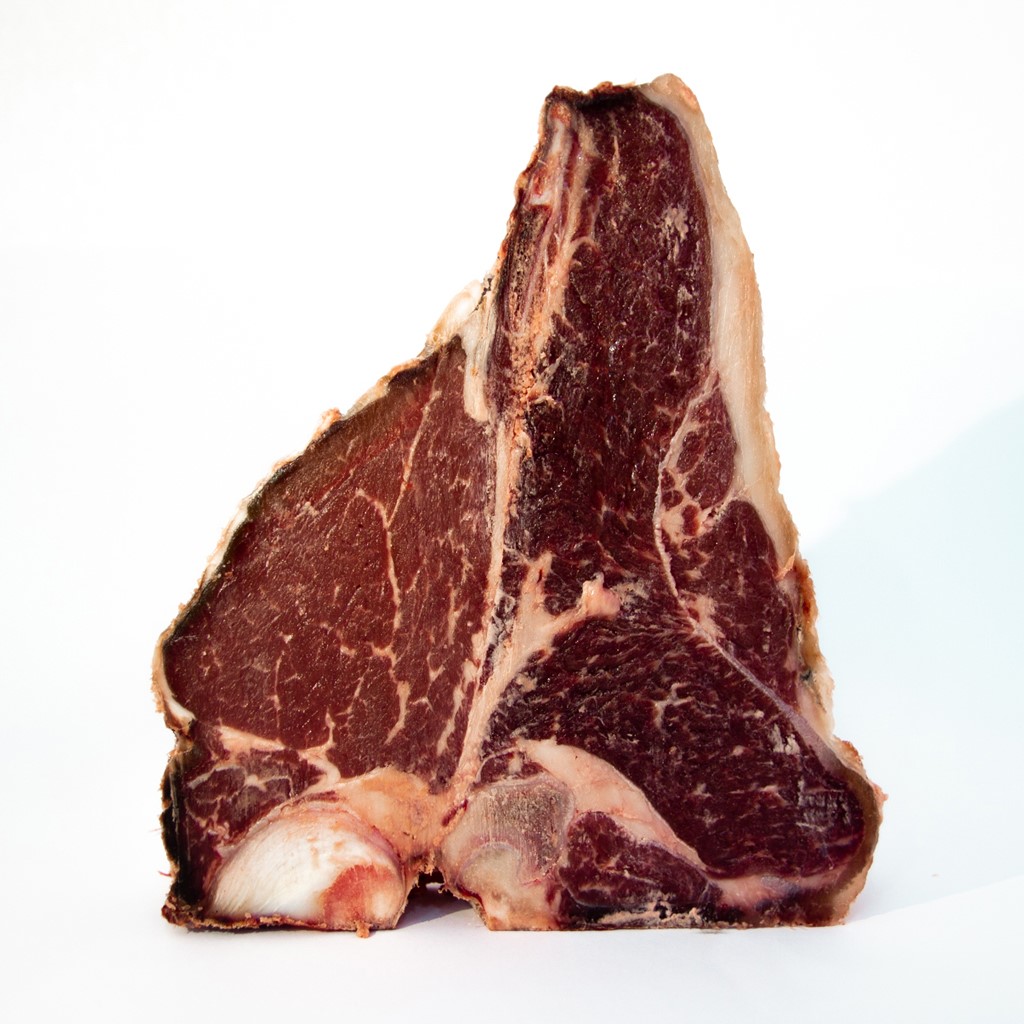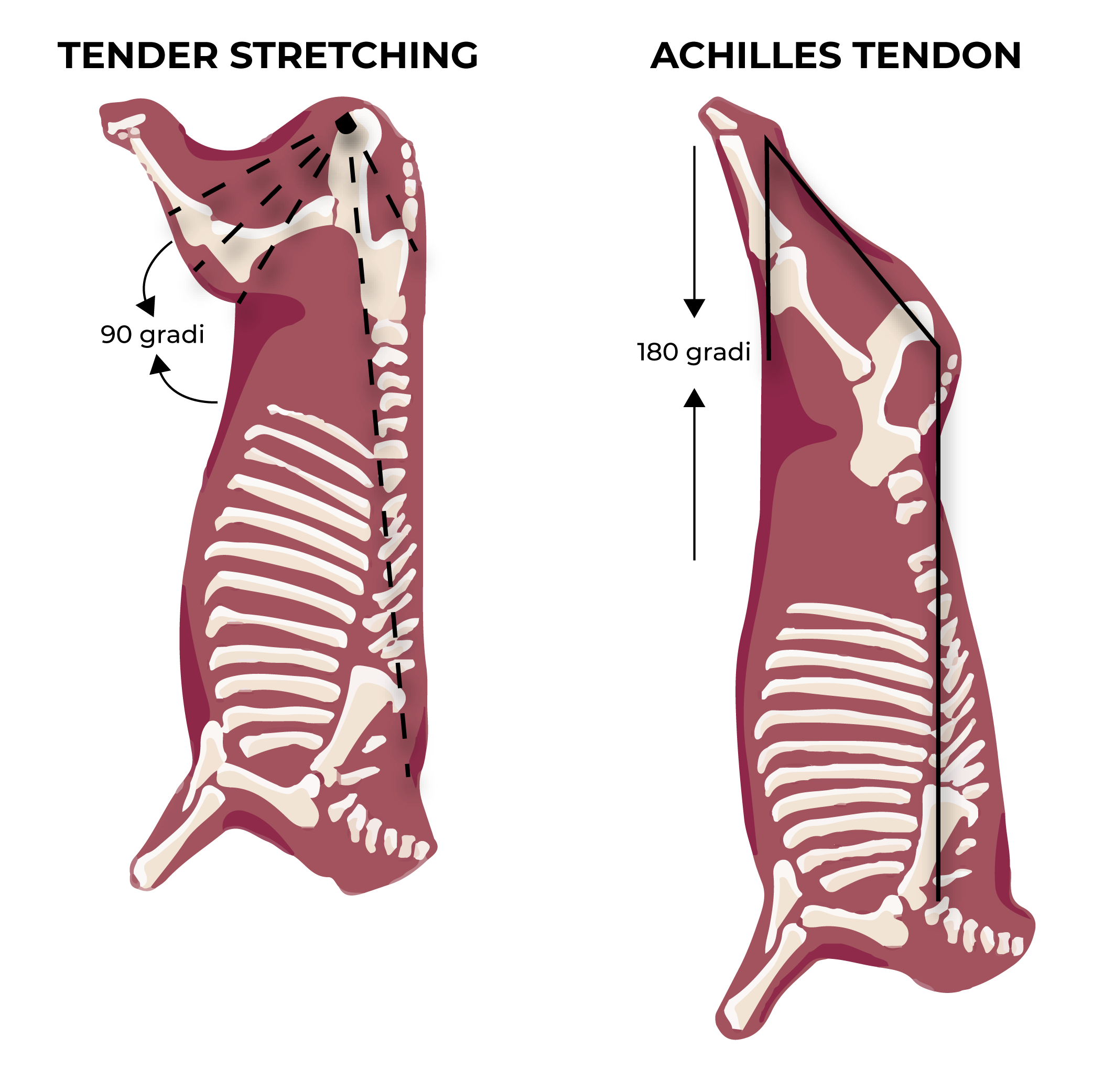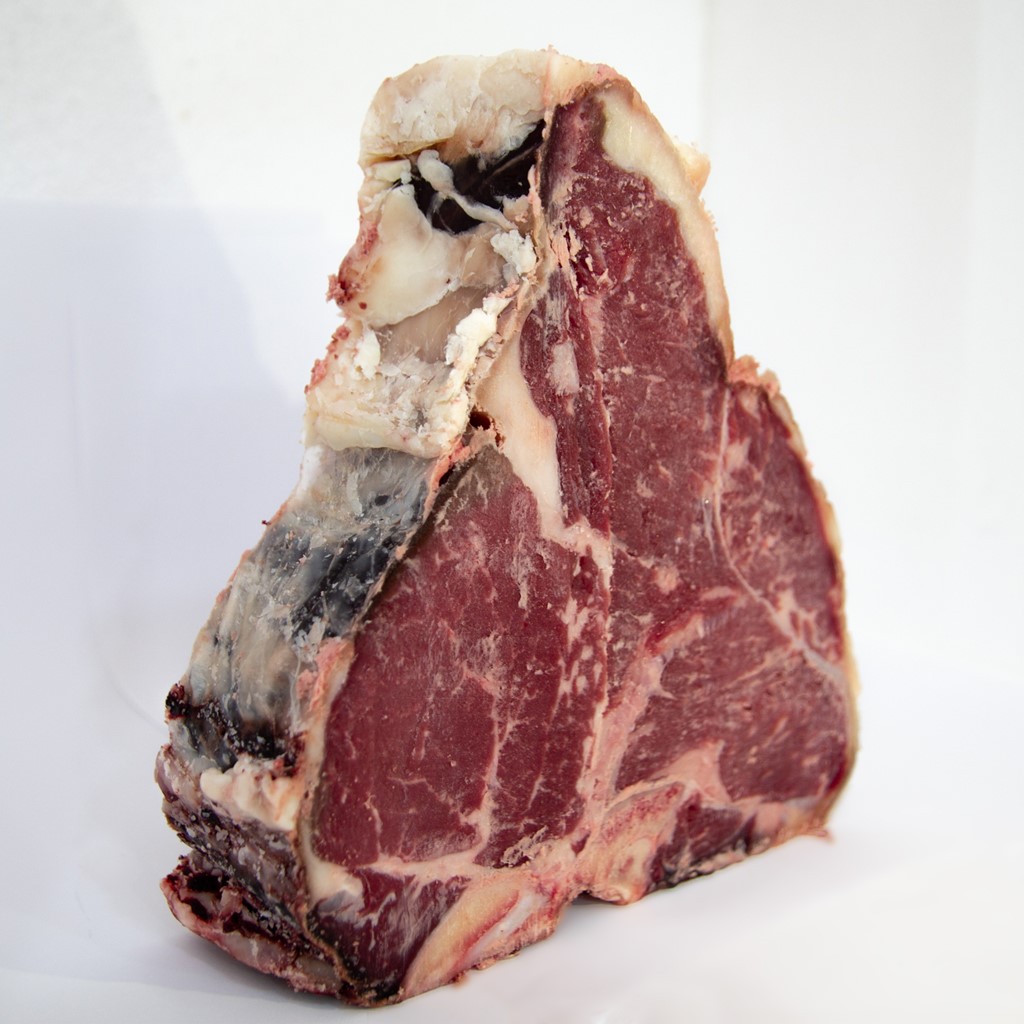Meat quality improvement indexes through the “maturation” process with systems and innovative pH-controlled maturation methods, the “Cuomo Method”.
Each piece butchered, regardless of the cut, is presented to the customer as a unique work of art. The comparison that lends itself easily to an overview in a meat shop is the juxtaposition of a single anatomical piece, similar to a piece of clothing displayed in the shop window, ready to be purchased by the customer. Behind this piece of meat is the story of the living animal (its rearing, genetic selection, sex, breed, age, diet, handling, conservation, etc.), all factors that are widely studied in zoo technical engineering thanks to the contribution of systems and innovative methods based on scientific studies and evidence, applied to modern breeding systems with sustainable impact (see precision agriculture, for example). An index of meat quality improvement, featuring innovative and patented systems and methods, is offered by the process which today applies the CuomoMethod (European patent N°EP2769276B1 for pH-controlled maturation) through use of the Maturmeat® device, a piece of high-precision equipment that makes meat a safer functional food, tender and juicy with enhanced flavour. In order to understand what professional maturation is, we need to start from the beginning, i.e., from the butchered item to the piece of meat on display in the shop window, ready for use by the consumer. The freshly butchered meat appears tough and almost tasteless, making it almost inedible due to the structure of the muscle fibres and rigor mortis.
As the cadaveric rigidity and the formation of lactic acid (during the first 24 hours) wears off, a natural process of meat maturation takes place. Butchers in the past used to take advantage of this time to manipulate the meat, debone it, and market it fresh – just enough time for the muscle fibres to convert into edible meat. Insufficient space for double cold rooms and a lack of technological innovations for meat processing, prevented butchers from keeping meat exposed in cold rooms over long periods. Over the years, the consumer has therefore grown accustomed to buying freshly butchered meat, meaning, fresh meat that has been butchered 2-3 days beforehand, which therefore has a low and uncontrolled pH and must be consumed immediately in order not to lose its organoleptic characteristics, i.e. all the chemical-physical properties perceived by the sense organs (smell and sight) and which arouse emotional reactions in the individual of various intensities. In modern terms, maturation has a different meaning than in the past. It is now defined as a process that takes place in a pH-controlled environment with preservation of the meat for periods of various duration.

Times and methods vary depending on the characteristics of the animal (breed, age, size, feed, fattening phase, etc.), the type of cut and exposure of the product to air, the temperature, the pH and the relative humidity level in that specific environment. This process renders the meat safer, more tender, juicier, tastier and easier to digest for our bodies.
Tasting a Florentine steak always depends on those factors that influence the animal during its lifetime as well as during and after slaughter; that is, it depends on how it arrives on the plate. The perception of palatability will be more intense if, during the finishing phase (last 40-50 days) and before slaughter, the energy content of the animals feed is incremented, so that it takes on a greater reserve of sugars (in the form of glycogen) in its muscle tissue. Consequently, the pH of the slaughtered meat is kept at acidity values of around (5.7-6), which can counteract the activity of the putrescent microflora, which, due to fermentation, can quickly spoil the quality of the meat. You will therefore have a greater muscular conformation and a better quality of meat with a longer shelf life, maintaining colour, smell and organoleptic characteristics intact.
Palatability will be even greater if the steak undergoes a normal maturation period, which – for the modern consumer with a fine palate – is an essential prerequisite. Maturation can be defined as guided putrefaction upon which the 4 key elements of time, temperature pH and humidity are pivotal.
Maturation with the Cuomo Method and the Maturmeat® device: a question of class and parameters to be evaluated.
A peculiarity of meat is the amount of fat marbling and the pH, which is strongly influenced by the animal’s eating habits that, in our country, usually favour the use of lean meat, obtained from animals selected with moderate fat levels and butchered at maturation levels that are in line with market demands and, therefore, fairly moderate.
It is clear that a hyper-energetic diet, which is often associated with incorrect choices and habits and bad lifestyles, fat may constitute or turn into a problem.
But this long-standing question must be dealt with cum grano salis (so be aware of the use and distortion of information), fat can and should represent an important and primary qualitative parameter. It plays a fundamental role in nutrition becoming a benefit and not a problem when included in a good diet, together with a healthy lifestyle. All the more so if one takes into account the differences depending on the breed as well as the type of farming practice and the ways of use in the characteristics of the acidic profiles of meat. In fact, some breeds such as the Chianina, as well as other indigenous breeds, are favourable because of the fatty acid composition of the lipids they deposit, especially in relation to the ω6/ω3 ratio and the content of polyunsaturated fatty acids, with a positive effect on consumer health. In this sense, as mentioned above, they can influence certain types of breeding and feeding that respect animal welfare and its homeostasis.
We can therefore say that it is possible to eat meat (in the right quantities) without having to give up on tenderness, taste, etc.. (Palatability), characteristics known to be linked to lipid content.
A “Florentine steak” cut to a thickness of two fingers (4/6cm) is about 1,000-1,500 g, while a rib steak weighs less than half this. As mentioned in fig. 1 below, a Florentine steak matured with the Cuomo Method and Maturmeat®, varies depending on the appearance of the characteristic marbling of the meat and therefore the degree of fat present in it, so we attribute 40 days of maturation if the meat features medium marbling, or 30 days if the marbling is abundant. For example, the sirloin cut of Chianina Calves must undergo a maturation process of at least 28 days in the Maturmeat® maturation cabinet. At the time of cooking, the meat should be at room temperature. As mentioned in the introduction, in a figurative sense, the maturation of various cuts of meat result in unique works of art, which bear the signature of their tailor in the “Cuomo Method” lettering. Each cut of meat that undergoes the maturation process must be subjected to protocols and manual operational processes or automated processes, in line with current European regulations.

Meat tenderisation and changes during maturation
The tenderness of the meat depends not only on the quantity and type of fat, but also on the level of degradation of contractile proteins by specific enzymes; on the percentage of collagen and, in particular, on insoluble collagen when cooked; and, finally, on the bonds of various strength in the connective tissue. Some important and easily measurable quality parameters allow us to evaluate the “maturation” trend and, therefore, to predict the final result of this important technological process. The initial pH value of raw ingredients (at the moment of purchase) is the first indicator of meat quality and allows us to evaluate the potential of the animal muscle to become a good steak: this parameter gives an indication of how well this food can be preserved. In fact, low pH values limit microbial growth and thus prevent possible alterations (DELL’ORTO and SGOIFO ROSSI, 2000).
Each enzymatic complex active post-mortem in the muscles has characteristic optimal pH values, accordingly, the tenderness, aroma, water retention and colour of the flesh are influenced by the pH itself, which thus takes on considerable importance in the transformation of the muscle after slaughter (PANELLA et al., 1995; DELL’ORTO and SGOIFO ROSSI, 2000).
The Myofibrillar Fragmentation Index (MFI) is an indicator of the level of degradation of the sarcoplasmic component, closely related to the softening process of the meat. The cutting force (WBs) measures the force required to cut the muscle fibres by means of a dynamometer: the closer these fibres are joined together, the more difficult it is to cut them. From all these factors, the reader will understand how important a safe and professional maturation period is, which should not be improvised with the use of normal refrigerators, and can only be achieved with devices and methods that have been certified for this purpose.
The influence of breed and maturation with the patented Cuomo Method
Studies on beef have highlighted the importance of its role in the human diet, during all age stages of an individual’s development. An Analysis of the quality of the meat has revealed its high nutritional value, in particular for the composition of long-chain fatty acids of the ω6 and ω3 series. To this, we can add its high antioxidant power and the benefits it offers for the circulatory system due to the presence of coenzyme Q10 and carnosine, as well as microelements such as zinc.
A lack of these elements contributes to the formation of oxidative stress, interfering with the functionality of the male organ by causing a reduction in the number of spermatozoa and their motility (oligoasthenospermia). In these subjects, examination of the seminal fluid (spermiogram) revealed deficiencies of D-aspartic acid, zinc, vitamin E, carnitine and other substances with an antioxidant action, such as coenzyme Q10, compared to individuals with no fertility problems (normospermic subjects). All of these substances conserve the product long-term and fight free radicals. A typical northern breed such as the Chianina, due to its powerful size, has been criticised for the innate hardness of its flesh, an element that does not play in favour of these animals. This problem of meat hardness can be overcome by extending to 28 days – and for certain commercial cuts to 28 – 40 days of maturation using various softening techniques (chemical, physical and mechanical), including tender stretching or suspension by the pelvis instead of the classic method of suspension by the Achilles tendon.

Study by the CRA-PCM (Centre for Meat Production and Genetic Improvement) of Monterotondo Scalo (Rome) on Chianina meat. This highly efficient system was developed several years ago, but only in an experimental context. It is now ready to be transferred to the field with excellent results. Instead of the classic method of suspension by the Achilles tendon, tender stretching or suspension by the pelvis is applied in Maturmeat® cabinets and cold rooms and only during the first 24 hours following slaughter. Afterwards, the carcass are suspended normally, significantly softening the meat and reducing the maturation time. The main action is due to the gravitational forces inside the devices patented method invented by Cuomo: these are dependent on the weight of the carcass, which is distributed in a different way (marked with black vectors inside Figure 2 for the two different types of suspension).
With traditional suspension, these distribute along the bones without bringing substantial benefits due to the traction of the muscle. With the tender stretching technique, however, these forces spread across the entire rear quarter, where the main commercial cuts of meat are obtained. The effect on meat hardness as well as on collagen solubility and myofibrillar degradation is notable, with promising results for the resolution of the problem of tenderness in Chianina and Podolica meat.
These and other native breeds, which, due to the management of breeding facilities, provide high-quality meat, excellent for use with the Stagionello® and Maturmeat® patented systems. Systems which use a scientifically validated method of meat maturation, evaluated by the University of Naples – Department of Veterinary Medicine, and the second Luigi Vanvitelli University in Italy, by the IRTA (Institute of Research and Food Technology) in Spain and recognised as the method of maturation at a safe pH level with European Patent No. EP2769276B1 of the EPO (European Patent Office).
Dr. Alfonso Piscopo
Veterinary Director ASP Agrigento
SSN Veterinarian